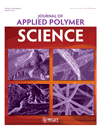Curing characteristics and mechanical properties of rattan-powder-filled natural rubber composites as a function of filler loading and silane coupling agent
Abstract
Curing characteristics, tensile properties, morphological studies of tensile fractured surfaces using scanning electron microscopy (SEM), and the extent of rubber filler interactions of rattan-powder-filled natural rubber (NR) composites were investigated as a function of filler loading and silane coupling agent (CA). NR composites were prepared by the incorporation of rattan powder at filler loading range of 0–30 phr into a NR matrix with a laboratory size two roll mill. The results indicate that in the presence of silane CA, scorch time (ts2), and cure time (t90) of rattan-powder-filled NR composites were shorten, while, maximum torque (MH) increased compared with NR composites without silane CA. Tensile strength and tensile modulus of composites were enhanced whereas elongation at break reduced in the presence of silane CA mainly due to increase in rubber-filler interaction. It is proven by SEM studies that the bonding between the filler and rubber matrix has improved. © 2011 Wiley Periodicals, Inc. J Appl Polym Sci, 2012




